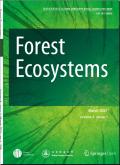环境变量对两种针叶林不同生长季节冠层蒸腾的影响
IF 4.4
1区 农林科学
Q1 FORESTRY
引用次数: 0
摘要
土壤含水量(SWC)和气象条件作为影响树木水分利用的关键环境变量,在生长季节变化很大,阻碍了对林冠蒸腾(Ec)的环境控制机制的更好理解。解开这些变量在生长季节阶段对生态系统的影响对于生态系统估算和森林管理至关重要。在这项研究中,43岁的油松(Pinus tabulformis Carr)。31年生侧柏(Platycladus orientalis)对2015-2020年半干旱黄土高原Franco人工林进行了Ec监测。利用增强回归树(boosting regression tree, BRT)模型评估了环境因子对Ec的贡献。结果表明,土壤水分有效度较高的中期(7 ~ 8月)土壤水汽压亏缺(VPD)和太阳总辐射(Rs)对土壤水分有效度的贡献增大,而土壤水分有效度较高的前期(5 ~ 6月)和后期(9月)土壤水分有效度较高。总体而言,2个人工林的Ec以SWC(20.4%≤贡献≤48.8%)和Rs(22.7%≤贡献≤35.8%)为主。两种植物均表现出较强的气孔调节作用。其中,早期VPD显著抑制气孔开启,后期SWC强烈影响气孔开启。研究表明,人工林土壤水分条件应根据影响因子的变化进行调整。特别是在早期和后期阶段,可以采取措施(如整地、疏林和修剪)来改善这类旱地森林的土壤湿度。本文章由计算机程序翻译,如有差异,请以英文原文为准。
Effects of environmental variables on canopy transpiration in two coniferous forests at different growing-season stages
Soil water content (SWC) and meteorological conditions, as key environmental variables influencing tree water use, vary highly within the growing season, hindering a better understanding of environmental control mechanisms on canopy transpiration (Ec). Disentangling the effects of these variables on Ec across growing-season stages is crucial for Ec estimation and forest management. In this study, 43-year-old Pinus tabuliformis Carr. and 31-year-old Platycladus orientalis (L.) Franco plantations in the semiarid Chinese Loess Plateau were monitored for Ec during the growing season of 2015–2020. The contributions of environmental factors to Ec were assessed using the boosted regression tree (BRT) model. Results showed that the contributions of SWC to Ec were greater at the early (May–June) and late (September) stages, while the contributions of vapor pressure deficit (VPD) and total solar radiation (Rs) to Ec increased at the middle (July–August) stage due to high soil water availability. Overall, Ec in both plantations was dominated by SWC (20.4% ≤ contributions ≤ 48.8%) and Rs (22.7% ≤ contributions ≤ 35.8%). Both species exhibited strong stomatal regulation of Ec. Specifically, stomatal opening was significantly inhibited by VPD at the early stage and strongly affected by SWC at the late stage. This study highlights that soil water conditions in artificial forests should be adjusted according to changes in influencing factors on Ec. Particularly during the early and late stages, measures (e.g., land preparation, thinning, and pruning) can be implemented to improve soil moisture in such dryland forests.
求助全文
通过发布文献求助,成功后即可免费获取论文全文。
去求助
来源期刊

Forest Ecosystems
Environmental Science-Nature and Landscape Conservation
CiteScore
7.10
自引率
4.90%
发文量
1115
审稿时长
22 days
期刊介绍:
Forest Ecosystems is an open access, peer-reviewed journal publishing scientific communications from any discipline that can provide interesting contributions about the structure and dynamics of "natural" and "domesticated" forest ecosystems, and their services to people. The journal welcomes innovative science as well as application oriented work that will enhance understanding of woody plant communities. Very specific studies are welcome if they are part of a thematic series that provides some holistic perspective that is of general interest.
 求助内容:
求助内容: 应助结果提醒方式:
应助结果提醒方式:


